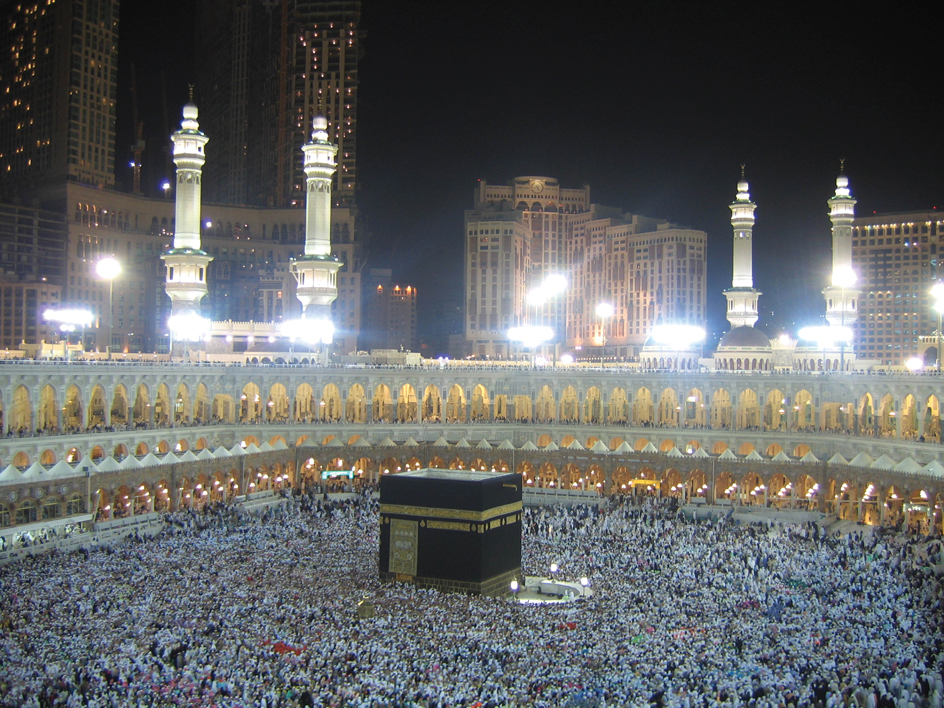Mecca << MEHK uh >> (pop. 2,385,509) is the holiest city of Islam, the religion of the Muslims. It lies in western Saudi Arabia in a dry, barren valley that is surrounded by desolate hills and mountains. The city is the birthplace of Muhammad, the prophet of Islam. Mecca is also the site of the Ka`ba << KAH buh >>, the shrine that Muslims face when they pray.

Only Muslims may enter Mecca, which Islam considers to be a sacred city. Islam requires every Muslim to make the hajj (a pilgrimage to Mecca) at least once if he or she is able to do so (see Hajj).
The city.
The Great Mosque, the center of worship for all Muslims, stands in the heart of Mecca. The outside of the mosque consists of an arcade, a series of arches supported by pillars. The arcade encloses a courtyard that is about 600 by 800 feet (180 by 240 meters). The Ka`ba, a cube-shaped stone building, is in this area. The Black Stone, which Muslims believe was sent from heaven by Allah (God), is the eastern cornerstone of the Ka`ba.

In the 1950’s, the Saudi government began a program to modernize Mecca. This program included the construction of tall, modern hotels for pilgrims. The government also added lighting and other facilities, built better roads, and increased the health and security services of the community. Modern houses replaced numerous traditional dwellings. New suburbs were also built, and many wealthy Meccans moved to those areas. Mecca is the home of Umm Al-Qura University and the Madrasah Ahl Al Hadith, an institute of Islamic studies. One of Saudi Arabia’s royal palaces is in Mecca.
People.
In the past, many Muslims who came to Mecca on the hajj settled there later. The city’s population became a mixture of various nationalities. But since the 1930’s, the government has strongly discouraged immigration to Mecca because it wants to preserve jobs in the area for people of Saudi Arabia.
Economy
of Mecca depends on money spent by pilgrims. A hajj must be made between the 8th and 13th day of the last month of the Muslim year. About 2 million pilgrims crowd into Mecca within those few days. About half of them come from other countries.

Mecca has some minor industries. For example, a factory makes products from clay. But the city no longer plays a major part in Saudi Arabia’s economy, which has been based on oil exports since the late 1940’s.
History.
Mecca became a trading center about A.D. 500. The people of Mecca worshiped many gods, whose idols stood at the Ka`ba. Muhammad was born in the city about 570.
The Meccans rejected Muhammad’s religious teachings, and he and his disciples fled from the city in 622. Eight years later, Muhammad and his followers captured Mecca and destroyed the idols. They spared the Ka`ba, which has remained as the Muslim shrine.
Mecca became the heart of the first Arab-Islamic empire. The city’s political importance declined during the mid-600’s, when Muslim conquests spread through distant lands. But Mecca kept its importance as the religious center of Islam.
A series of sharifs (descendants of Muhammad) ruled Mecca from 960 until 1924. That year, Abd al-Aziz ibn Saud, an Arab leader, conquered the city. Mecca became part of his kingdom, which he named Saudi Arabia in 1932. Since the 1950’s, the Saudi government has worked to modernize Mecca and to ensure the comfort and safety of pilgrims to the city. During the 1970’s and 1980’s, Mecca experienced major population growth as many rural people moved there.
